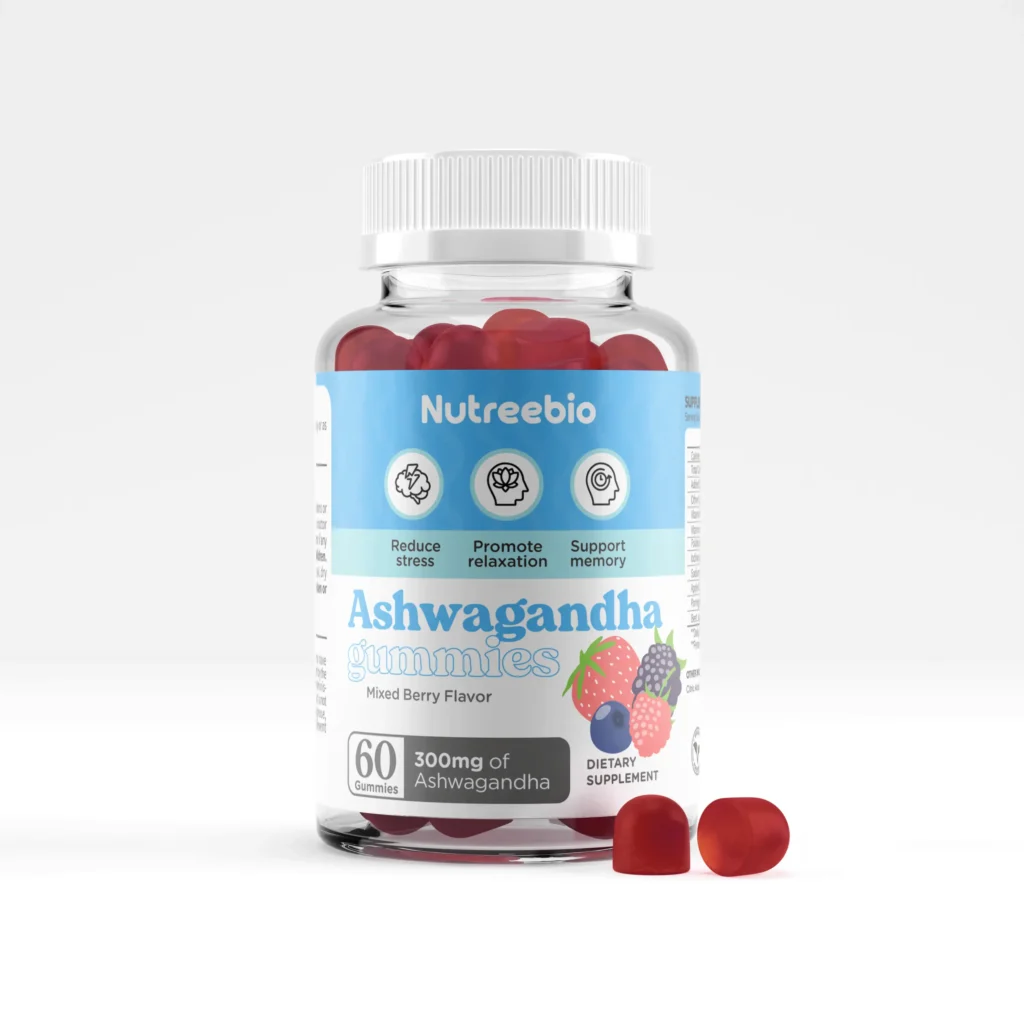Abstract
(1)Benefits of Ashwagandha
- Lowering blood sugar and blood lipids
- Regulating immunity
- Calming function
- Protecting nerves
(2)Application of Ashwagandha products
- Softgel: Ashwagandha softgels are usually used for easy taking and efficient absorption. Softgels can encapsulate liquid extracts and provide a more stable dosage form. Organic Ashwagandha Softgels, which are commonly found on the market, contain high concentrations of Ashwagandha extracts and are used for stress resistance and immune enhancement.
- Pills and Tablets: Ashwagandha Pills and Tablets are another convenient form of taking, suitable for daily supplementation. Ashwagandha Tablets on the market are used to reduce stress and anxiety and improve mood.
- Gummy: Ashwagandha gummies are a popular dosage form in recent years, especially for those who do not like to swallow pills or capsules. Ashwagandha gummies are mainly used for stress resistance and mood improvement, as well as enhancing immunity.
- Powder: Ashwagandha powder is one of the most flexible forms. Organic Ashwagandha powder on the market is suitable for adding to smoothies or teas. This high-quality Ashwagandha powder is mainly used to boost energy and enhance immunity.
(3)Popular countries
Ashwagandha, as a traditional herb, is widely used in the following countries:
- India: Ashwagandha plays an important role in Ayurveda traditional medicine and is widely used to relieve stress, enhance immunity and increase energy.
- United States: In the dietary supplement market, Ashwagandha is popular and is mainly used as a supplement for stress relief and energy boosting.
- Canada: As a natural health product, Ashwagandha is widely used for stress relief and immune enhancement.
- United Kingdom: Ashwagandha is becoming increasingly popular in the natural and organic health products market.
- Australia: As a herbal supplement, Ashwagandha is used in a variety of health products.


Article Content
Ashwagandha, also known as Indian ginseng or winter cherry, is a shrub of the Solanaceae family with a variety of medicinal properties. It is an ancient plant native to India and can be found everywhere. It has always been used by the Indian people as an important medicinal material for inducing sleep, nourishing and strengthening the body, and treating a variety of diseases. Ashwagandha has an improving effect on the brain metabolism of mice. At the same time, the ashwagandha extract powder contains at least withanolide glycosides and oligosaccharides and free withaferin A, which can effectively improve cognitive and learning abilities, reduce stress, have an immunomodulatory effect, and can increase the activity of antioxidant defense enzymes. At present, more and more studies have shown that the active ingredients in ashwagandha, such as alkaloids, steroidal lactones, ashwagandha lactones, and iron, also have a variety of physiological functions.
1. Efficacy of ashwagandha
A. Lowering blood sugar and blood lipids
Ashwagandha has the effect of lowering blood sugar and blood lipids. Some scholars used glibenclamide as a positive drug in a diabetic rat model induced by alloxan, and glyburide was administered with total flavonoids extracted from the roots and leaves of South African somniferum. After 8 weeks of glycation, relevant indicators were detected. Compared with the model group, urine sugar, blood sugar, and glycosylated hemoglobin in each experimental group were significantly reduced, and hemoglobin and liver glycogen were significantly increased; total cholesterol TC, triglycerides TG, phospholipids PL and low-density lipoprotein in serum, liver, kidney and heart lipids were significantly reduced, and high-density lipoprotein was significantly increased; serum, liver, kidney and heart protein were significantly increased. This shows that flavonoids extracted from South African somniferum can significantly reduce blood sugar and blood lipids in model rats.
B. Immunomodulation
Currently, many studies have pointed out the immunomodulatory effects of South African somniferum and its extracts. There are also studies that simulate the molecular mechanism of immunomodulation of South African somniferum and contribute to the development of drugs based on bioactive formulas. Some scholars found that in cyclophosphamide model mice, ashwagandha significantly increased the number of white blood cells and platelets, and significantly increased the degree of hemagglutination in the serum hemolysin experiment sensitized by sheep red blood cells. Later, some scholars also studied the immunomodulatory effects of ashwagandha leaf extracts F5 and F6. Mice were infected with Leishmania donovani for 30 days to build an animal model. The IgG2a of the ashwagandha leaf extracts F5 and F6 treatment groups was significantly higher than that of the model group.
C. Sedative function
As people's work and life pace accelerates and competition becomes fierce, the prevalence of mental illnesses (such as depression, anxiety, and sleep disorders) that seriously endanger human physical and mental health has increased year by year. At present, they are mainly treated or controlled by drugs (benzodiazepines, buspirone, etc.), which have great side effects. Some studies have shown that ashwagandha has sedative and anti-anxiety functions. Some scholars established a sleep disorder mouse model, set up a control group, a model group, a 100mg/kg ashwagandha root extract group, a 200mg/kg ashwagandha root extract group, a 0.5mg/kg diazepam group, and a 0.5mg/kg diazepam + 100mg/kg ashwagandha root extract group, gavage for 5 days, and detect relevant indicators. Compared with the model group, the 100mg/kg ashwagandha root extract group, the 200mg/kg ashwagandha root extract group, and the 0.5mg/kg diazepam group significantly increased body weight, improved autonomous activity, reduced anxiety levels, and increased glutathione and hydrogen peroxide.
D. Protect nerves
One aspect of the neuroprotective effect of South African ashwagandha is the ability to induce neurogenesis, which is believed to play a rehabilitative role in cognitive decline. Some scholars pointed out in the latest study that South African ashwagandha can well improve the behavioral defects of mice with cognitive disorders induced by bisphenol A, increase N-methyl-D-aspartate receptors in the hippocampus, and improve the level of endogenous antioxidants. After rats were given 100, 200, and 300 mg/kg of ashwagandha extract for 3 weeks, 6-hydroxydopamine was used to build a Parkinson's rat model. Neurological behavioral characteristics were detected after 3 weeks. After 5 weeks, the rats were killed to detect the content of lipid peroxides, reduced glutathione, and catecholamines, and the activities of glutathione-S-transferase, glutathione reductase, glutathione peroxidase, and tyrosine hydroxylase. The experimental results showed that ashwagandha extracts can significantly improve these indicators. In addition, studies have shown that ashwagandha can protect neuronal damage in Parkinson's patients. A study used ashwagandha root extracts to conduct 5 experiments including electrical stimulation (ECS) passive avoidance reaction of mice and cross maze to confirm its improvement of brain metabolism in mice.

2. Regulatory dynamics
Ashwagandha can be sold as a plant extract or as an ingredient added to supplements (such as gummies). The EU and the US are gradually improving the regulatory regulations for ashwagandha. Certain EU countries, such as Poland, have set a daily intake standard of no more than 3 grams of ashwagandha root extract and no more than 10 milligrams of withaferin per person.
3. Market Application and Product Dynamics
Ashwagandha is widely used in the health care market as a dietary supplement, and its claimed benefits include stress relief, emotional balance and body support. At the same time, ashwagandha is also added to beverages. Adding a variety of super ingredients including ashwagandha to functional beverages can help the body obtain lasting energy, and the antioxidant ingredients it contains can also promote body metabolism and enhance immunity. In the field of daily chemicals, ashwagandha-derived products include essential oils, hair oils, essences and bath gels, which are widely used in human skin care.
4. Current Status of Production Technology
The main active ingredients in ashwagandha are its withanolides, alkaloids, steroids and other active ingredients. At present, it is mainly extracted from the roots of ashwagandha or the roots and leaves at the same time. Extraction from the roots of ashwagandha can extract more than 5% of withanolides. Extraction from the roots and leaves of South African somniferum can extract more than 10% of withanolide glycosides, including active ingredients such as Withanolide glycosides, Withaferin A and Oligosaccharides, which are water-soluble and suitable as auxiliary ingredients.
To enrich withanolide glycosides from South African somniferum, the dried South African somniferum roots need to be crushed or sliced, water is added, temperature-controlled soaking is performed, ethanol is added, and the temperature is raised and stirred for extraction. The extract is concentrated, macroporous resin is slowly added for adsorption, and after sufficient adsorption, it is eluted with an ethanol-water system, and the eluate is collected. The eluate is then concentrated under reduced pressure, the ratio of ethanol to water in the concentrate is adjusted, cooled, allowed to stand, filtered, the filtrate is concentrated, dried under reduced pressure, and crushed to obtain a component rich in withanolide glycosides.
5. Introduction to technical achievements
This technology uses lactic acid bacteria to ferment South African somniferum extracts, and provides a fermentation method for improving the antioxidant activity of South African somniferum extracts, which significantly increases the total phenol content in the extract and improves the antioxidant activity. The product obtained by this method can also significantly improve the flavor of food, while broadening the application form of ashwagandha extract and enriching the related product forms with ashwagandha as the main raw material.
This technology first prepares ashwagandha extract, takes ashwagandha root powder, crushes, adds water, and boils to obtain ashwagandha extract liquid, and then converts the extract liquid into powder or extract by spray drying. The powder or extract obtained above is prepared into a fermentation matrix containing ashwagandha extract. Then Lactobacillus plantarum, Lactobacillus casei, Lactobacillus acidophilus, and Lactobacillus fermentum are coated on MRS solid plates for activation, and single colonies are picked into MRS liquid culture medium, and cultured after two subcultures, and then the culture solution is centrifuged to remove the supernatant, rinsed and resuspended to obtain concentrated seed liquid. Finally, any one or more combinations of seed liquid are inoculated into the fermentation matrix and fermented for 24-120 hours.
After fermenting the ashwagandha extract with lactic acid bacteria, the total phenol content in the extract increased by 12.3-36.1% compared with before fermentation, the DPPH free radical scavenging ability increased by 48.65-59.7%, the ABTS free radical scavenging ability increased by 1.2-6.4%, the FRAR value of iron ion reducing power increased by 9.1-44.1%, and the total antioxidant capacity was 9.7-36.7%.

6. Conclusion
More and more studies have shown that the active ingredients in ashwagandha, such as withanolides, alkaloids, and steroids, have multiple physiological functions such as lowering blood sugar and blood lipids, improving immunity, protecting nerves, and relieving stress. It is believed that with the rising health demands of consumers and the deepening of theoretical and clinical research, there will be more products based on more natural and healthy ashwagandha ingredients.


